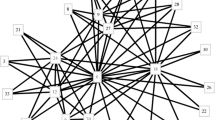Abstract
Let d3(n,k) be the maximum possible minimum Hamming distance of a ternary [ n,k,d;3]-code for given values of n and k. It is proved that d3(44,6)=27, d3(76,6)=48,d3(94,6)=60 , d3(124,6)=81,d3(130,6)=84 , d3(134,6)=87,d3(138,6)=90 , d3(148,6)=96,d3(152,6)=99 , d3(156,6)=102,d3(164,6)=108 , d3(170,6)=111,d3(179,6)=117 , d3(188,6)=123,d3(206,6)=135 , d3(211,6)=138,d3(224,6)=147 , d3(228,6)=150,d3(236,6)=156 , d3(31,7)=17 and d3(33,7)=18 . These results are obtained by a descent method for designing good linear codes.
Similar content being viewed by others
References
G. Bogdanova and I. Boukliev, New linear codes of dimension 5 over GF(3), Proc. Inter. Workshop ACCT-94, Novgorod, Russia (1994) pp. 41–43.
A. E. Brouwer and M. van Eupen, The correspondence between projective codes and 2-weight codes, Designs, Codes and Cryptography (to appear).
R. N. Daskalov, Bounds for binary and ternary linear codes, Ph.D. Thesis (1993).
M. van Eupen, Five new optimal ternary linear codes, IEEE Trans. Info. Theory, Vol. 40 (1994) p. 193.
M. van Eupen, Four non-existence results for ternary linear codes, IEEE Trans. Inform. Theory, Vol. 41 (1995) pp. 800–805.
M. van Eupen, Some new results for ternary linear codes of dimension 5 and 6, IEEE Trans. Inform. Theory, Vol. 41,No. 6 (1995) pp. 2048–2051.
M. van Eupen, N. Hamada and Y. Watamori, The nonexistence of ternary [50, 5, 32] codes, Designs, Codes and Cryptography, Vol. 7,No. 3 (1996) pp. 235–237.
M. van Eupen and R. Hill, An optimal termary [69, 5, 45] code and related codes, Designs, Codes and Cryptography, Vol. 4,No. 3 (1994) pp. 271–282.
J. H. Griesmer, A bound for error-correcting codes, IBM J. Res. Devel., Vol. 4 (1960) pp. 532–542.
T. A. Gulliver, New optimal ternary linear codes, IEEE Trans. Inform. Theory, Vol. 41 (1995) pp. 1182–1185.
T. A. Gulliver and V. K. Bhargava, Some best rate 1/p and rate (p − 1)/p systematic quasi-cyclic codes over GF(3) and GF(4), IEEE Trans. Inform. Theory, Vol. 38 (1992) pp. 1369–1375.
T. A. Gulliver and V. K. Bhargava, New good rate (m − 1)/pm ternary and quaternary quasi-cyclic codes, Designs, Codes and Cryptography (to appear).
F. R. Kschischang and S. Pasupathy, Some ternary and quaternary codes and associated sphere packings, IEEE Trans. Inform. Theory, Vol. 38 (1992) pp. 227–246.
I. Landgev, Nonexistence of [143, 5, 94]3 Codes, Proc. Inter. Workshop OCRT'95, Sozopol, Bulgaria (1995) pp. 108–116.
N. Hamada, A survey of recent work on characterization of minihypers in P G(t, q) and nonbinary linear codes meeting the Griesmer bound, J. Combin. Inform. Syst. Sci., Vol. 18 (1993) pp. 161–191.
N. Hamada, The nonexistence of [303, 6, 201; 3]-codes meeting the Griesmer bound, Technical Report OWUAM-009, Osaka Women's Univ., Sakai, Osaka 590, Japan (1995).
N. Hamada and T. Helleseth, The uniqueness of [87, 5, 57; 33]-codes and the nonexistence of [258, 6, 171; 3]-codes, J. Statist. Plann. Inference (to appear).
N. Hamada and T. Helleseth, Construction of some optimal ternary codes and the uniqueness of [294, 6, 195; 3]-codes meeting the Griesmer bound, Finite Field and Their Application, Vol. 1 (1995) pp. 458–468.
N. Hamada and T. Helleseth, The nonexistence of ternary [270, 6, 179] codes and [309, 6, 205] codes, Proc. Inter. Workshop OCRT'95, Sozopol, Bulgaria (1995) pp. 65–68.
N. Hamada, T. Helleseth and Ø. Ytrehus, On the construction of a [q 4 + q 2 − q, 5, q 4 − q 3 + q 2 − 2q; q]-code meeting the Griesmer bound, Designs, Codes and Cryptography, Vol. 2 (1992) pp. 225–229.
N. Hamada and Y. Watamori, The nonexistence of [71, 5, 46; 3]-codes, J. Statist. Plann. Inference (to appear).
N. Hamada and Y. Watamori, The nonexistence of some ternary linear codes of dimension 6 and the bounds for n 3(6, d), 1 ≤ d ≤ 243, Math. Japonica, Vol. 43 (1996) pp. 577–593.
R. Hill, Optimal Linear Codes: Cryptography and Coding II (C. Mitchell, ed.), Oxford University Press (1992) pp. 75–104.
R. Hill, Caps and codes, Discrete Math., Vol. 22 (1978) pp. 111–137.
R. Hill and P.P. Greenough, Optimal quasi-twisted codes, Proc. Inter. Workshop ACCT-92, Voneshta voda, Bulgaria (1992) pp. 92–97.
R. Hill and D. E. Newton, Optimal ternary linear codes, Designs, Codes and Cryptography, Vol. 2,No. 2 (1992) pp. 137–157.
A. Said and R. Palazzo, Heuristic search: A new method to design good unit memory convolutional codes, Proc. Fourth Swedish-Soviet Inter. Workshop on Inf. Theory, Gotland, Sweden (1989) pp. 325–331.
G. Solomon and J. J. Stiffler, Algebraically punctured cyclic codes, Inform. and Control., Vol. 8 (1965) pp. 170–179.
Author information
Authors and Affiliations
Rights and permissions
About this article
Cite this article
Boukliev, I. Some New Optimal Ternary Linear Codes. Designs, Codes and Cryptography 12, 5–11 (1997). https://doi.org/10.1023/A:1008215724132
Issue Date:
DOI: https://doi.org/10.1023/A:1008215724132



